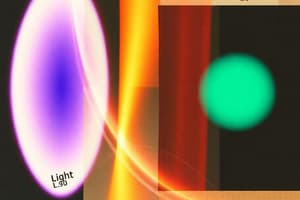Podcast
Questions and Answers
What is the angle of reflection in terms of light behavior?
What is the angle of reflection in terms of light behavior?
- The angle between the incident ray and the reflected ray
- The angle between the reflected ray and the normal (correct)
- The angle formed by rays converging at the focal point
- The angle between the incident ray and the normal
Which type of lens is thicker in the middle than at the edges?
Which type of lens is thicker in the middle than at the edges?
- Concave lens
- Cylindrical lens
- Plano-concave lens
- Convex lens (correct)
What occurs at the focal point of a lens?
What occurs at the focal point of a lens?
- Light rays converge (correct)
- Light rays reflect off the lens
- Light rays remain parallel
- Light rays diverge
What results from the interaction of light with a prism?
What results from the interaction of light with a prism?
What characterizes a virtual image?
What characterizes a virtual image?
What phenomenon occurs when light bounces off a surface?
What phenomenon occurs when light bounces off a surface?
What type of mirror creates an upright, laterally inverted image that is the same size as the object?
What type of mirror creates an upright, laterally inverted image that is the same size as the object?
Which lens type causes light rays to converge?
Which lens type causes light rays to converge?
What part of the human eye is responsible for converting light energy into electrical signals?
What part of the human eye is responsible for converting light energy into electrical signals?
How does a prism separate white light into its component colors?
How does a prism separate white light into its component colors?
What phenomenon describes the bending of light as it passes from one medium to another?
What phenomenon describes the bending of light as it passes from one medium to another?
Which of the following statements is true regarding complementary colors?
Which of the following statements is true regarding complementary colors?
What is the approximate speed of light in a vacuum?
What is the approximate speed of light in a vacuum?
Flashcards
Angle of incidence
Angle of incidence
The angle between the incident ray and the normal, an imaginary line perpendicular to the surface at the point where the light hits.
Angle of reflection
Angle of reflection
The angle between the reflected ray and the normal, the line perpendicular to the surface at the point of incidence.
Lens
Lens
A transparent object with at least one curved surface that bends light as it passes through.
Focal point
Focal point
Signup and view all the flashcards
Focal length
Focal length
Signup and view all the flashcards
What is light?
What is light?
Signup and view all the flashcards
What is reflection?
What is reflection?
Signup and view all the flashcards
What is refraction?
What is refraction?
Signup and view all the flashcards
What happens when light hits a concave mirror?
What happens when light hits a concave mirror?
Signup and view all the flashcards
What happens when light hits a convex mirror?
What happens when light hits a convex mirror?
Signup and view all the flashcards
How does the human eye work?
How does the human eye work?
Signup and view all the flashcards
What is white light?
What is white light?
Signup and view all the flashcards
How do pigments work with light?
How do pigments work with light?
Signup and view all the flashcards
Study Notes
Light as a form of energy
- Light is a form of electromagnetic radiation.
- It travels in straight lines called rays.
- Light can be reflected, refracted, and absorbed.
- Light is made of tiny particles called photons.
- The speed of light in a vacuum is approximately 300,000,000 meters per second.
Reflection of light
- Reflection is the bouncing of light off a surface.
- The angle of incidence is equal to the angle of reflection.
- Plane mirrors produce virtual images.
- The image formed by a plane mirror is upright, laterally inverted, and the same size as the object.
- Concave mirrors converge light rays.
- Convex mirrors diverge light rays.
Refraction of light
- Refraction is the bending of light as it passes from one medium to another.
- Refraction occurs because light travels at different speeds in different mediums.
- The amount of bending depends on the angle of incidence and the refractive indices of the two mediums.
- A lens is a transparent object with at least one curved surface that refracts light.
- Concave lens causes light to diverge.
- Convex lens causes light to converge.
- The refractive index of a medium is a measure of how much light slows down when passing through that medium, compared to the light's speed in a vacuum. A higher refractive index implies a slower speed.
The human eye
- The human eye is an optical instrument that allows us to see.
- The cornea and lens refract light to focus it on the retina.
- The retina contains photoreceptor cells that convert light energy into electrical signals.
- The optic nerve transmits these signals to the brain, where they are interpreted as images.
Colour and Dispersion of light
- White light is a mixture of all colours of the rainbow.
- A prism separates white light into its component colours through dispersion.
- Pigment absorbs certain colours of light, while reflecting others. A blue object absorbs all colours except blue.
- Complementary colours are colours that when mixed together produce white light.
Applications of Light
- Light or optics are used in many applications such as photography, fiber optic communication, microscopes, telescopes.
- Photography uses lenses and light-sensitive materials to capture images.
- Fiber optics are used to transmit signals over long distances in telecommunications.
- Microscopes use lenses to magnify small objects, allowing us to see details that are not visible to the naked eye.
- Telescopes use lenses or mirrors to collect and focus light from distant objects, allowing us to view them in more detail.
- Lasers, a highly focused beam of coherent light, has diverse uses including cutting materials, reading barcodes, medical treatments, and communication systems. Lasers are used for precise measurements to achieve extremely high resolutions.
Important terms
- Angle of incidence: The angle between the incident ray and the normal.
- Angle of reflection: The angle between the reflected ray and the normal.
- Normal: A line perpendicular to the surface at the point of incidence.
- Incident ray: The ray of light that strikes a surface.
- Reflected ray: The ray of light that bounces off a surface.
- Virtual image: An image that cannot be projected onto a screen.
- Real image: An image that can be projected onto a screen.
- Focal length: The distance between the focal point and the center of a lens or mirror.
- Focal point: The point where parallel rays of light converge after passing through a converging lens or being reflected by a concave mirror.
- Refractive index: A measure of how much a substance slows down the speed of light.
- Prism: A triangular-shaped piece of glass or plastic that separates white light into its component colors.
- lens: A transparent object with at least one curved surface that refracts light.
- Convex lens: A lens that is thicker in the middle than at the edges.
- Concave lens: A lens that is thinner in the middle than at the edges.
- Photoreceptor cells: Specialized cells in the retina that respond to light.
- Pigment: A substance that gives a material its colour.
Studying That Suits You
Use AI to generate personalized quizzes and flashcards to suit your learning preferences.




